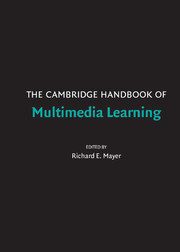Book contents
- Frontmatter
- Contents
- Preface
- Contributors
- 1 Introduction to Multimedia Learning
- PART I THEORETICAL FOUNDATIONS
- PART II BASIC PRINCIPLES OF MULTIMEDIA LEARNING
- PART III ADVANCED PRINCIPLES OF MULTIMEDIA LEARNING
- PART IV MULTIMEDIA LEARNING IN CONTENT AREAS
- PART V MULTIMEDIA LEARNING IN ADVANCED COMPUTER-BASED CONTEXTS
- 31 Multimedia Learning with Animated Pedagogical Agents
- 32 Multimedia Learning in Virtual Reality
- 33 Multimedia Learning in Games, Simulations, and Microworlds
- 34 Multimedia Learning with Hypermedia
- 35 Multimedia Learning in e-Courses
- Author Index
- Subject Index
- References
32 - Multimedia Learning in Virtual Reality
Published online by Cambridge University Press: 05 June 2012
- Frontmatter
- Contents
- Preface
- Contributors
- 1 Introduction to Multimedia Learning
- PART I THEORETICAL FOUNDATIONS
- PART II BASIC PRINCIPLES OF MULTIMEDIA LEARNING
- PART III ADVANCED PRINCIPLES OF MULTIMEDIA LEARNING
- PART IV MULTIMEDIA LEARNING IN CONTENT AREAS
- PART V MULTIMEDIA LEARNING IN ADVANCED COMPUTER-BASED CONTEXTS
- 31 Multimedia Learning with Animated Pedagogical Agents
- 32 Multimedia Learning in Virtual Reality
- 33 Multimedia Learning in Games, Simulations, and Microworlds
- 34 Multimedia Learning with Hypermedia
- 35 Multimedia Learning in e-Courses
- Author Index
- Subject Index
- References
Summary
Abstract
This chapter reviews the use of virtual reality to aid learning. First we give a description of virtual reality technology and the diverse ways in which it can be viewed and interacted with. Virtual reality has been used to support different types of learning in a variety of application areas including medical training, mainstream and special needs education, and rehabilitation. An overview of exemplary research in these areas is presented. Limitations of current research knowledge are discussed and recommendations for further work are made.
Introduction to Multimedia Learning in Virtual Reality
There are no single concise or generally accepted definitions of virtual reality and virtual environments. This is partly due to the continual state of evolution of the many technologies involved and also the terms being used in a variety of contexts. The Cambridge online dictionary defines virtual as; “something that can be done or seen using a computer and therefore without going anywhere or talking to anyone.” It defines virtual reality as “a set of images and sounds produced by a computer, which seem to represent a place or a situation that a person can experience or take part in” (http://dictionary.cambridge.org). The definition used in this chapter is that virtual reality describes the combination of systems comprising computer processing (PC-based or higher), a building platform for creating three-dimensional environments, and peripherals such as visual display and interaction devices that are used to create and maintain virtual environments. Virtual environments refer to the three-dimensional environments created.
- Type
- Chapter
- Information
- The Cambridge Handbook of Multimedia Learning , pp. 525 - 548Publisher: Cambridge University PressPrint publication year: 2005
References
- 13
- Cited by

